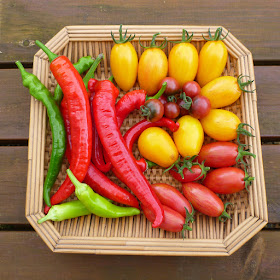Seed Harvest
This is the last harvest from my greenhouse this year. I'm going to save seed from all of these.
The tomatoes don't taste so great now but I've let a few ripen to use for seed as they're particularly good varieties which I want to grow again. Luckily, they didn't get blight so the seeds are ok to save.
Harvesting tomato seeds the traditional way is a bit of a fiddly business, so I turned to the internet to see what other people were doing. I came across a few good suggestions which I'm going to try.
The first thing to decide is how long you want to save your seed. If you just want it for next year, things are much simpler.
Harvesting tomato seeds the traditional way is a bit of a fiddly business, so I turned to the internet to see what other people were doing. I came across a few good suggestions which I'm going to try.
The first thing to decide is how long you want to save your seed. If you just want it for next year, things are much simpler.
Always start with clean, good-quality, ripe tomatoes and process one variety at a time.
Method 1. Plant the seeds. You can either halve the tomatoes and scoop out the flesh with all the seeds or just plant the halved tomatoes. Plant a couple of inches deep, either in a bed or pot of compost in the greenhouse. You can also plant outside. If you plant them outdoors, cover the soil with a deep mulch and mark the spot! In the spring, remove the mulch, stir the soil gently, cover with a cloche to warm things up - and you should get seedlings.
Method 2. Dry the seeds. This is a simple method. Use the tip of a knife to carefully pick out the seeds onto a piece of kitchen towel. Spread them out a bit and leave to dry for a few weeks. The seeds are coated in a gel which will stick when dry. When ready, fold the whole thing up and put in your seed envelope. Alternatively, position each seed onto a paper plate to dry, then pick them off.
More inventive ideas include setting the seeds directly onto a piece of tape or sections of kitchen roll / toilet tissue / coffee filter which will fit directly into your seed starter trays.
Method 3. Ferment the seeds. This method is for longer-term storage and involves cleaning the seeds before drying them. Cut the tomatoes and squeeze the seeds and juice into a container. Cover and soak at room temperature for 24 hours. Strain off any pulp and the juice, leaving just the seeds. Put the seeds in a strainer and rinse well with water to remove all the gel. Put the largest seeds on a paper plate to dry thoroughly for a week or so, turning regularly, before storing them in a cool, dry place.
If you're saving seed from more than one variety, mark them carefully at each stage of the process. I always think I'm going to remember which was which, but I never do!
Tomatoes are self pollinating, so if you save seed from open pollinated varieties they should come true to the parent plant. (You can also experiment with cross-pollinating.). F1 Hybrids are more difficult so you might want to try potting side shoots to keep indoors over the winter instead. I might try this with my non-hybrids too - but that's a whole other blog.
Method 1. Plant the seeds. You can either halve the tomatoes and scoop out the flesh with all the seeds or just plant the halved tomatoes. Plant a couple of inches deep, either in a bed or pot of compost in the greenhouse. You can also plant outside. If you plant them outdoors, cover the soil with a deep mulch and mark the spot! In the spring, remove the mulch, stir the soil gently, cover with a cloche to warm things up - and you should get seedlings.
Method 2. Dry the seeds. This is a simple method. Use the tip of a knife to carefully pick out the seeds onto a piece of kitchen towel. Spread them out a bit and leave to dry for a few weeks. The seeds are coated in a gel which will stick when dry. When ready, fold the whole thing up and put in your seed envelope. Alternatively, position each seed onto a paper plate to dry, then pick them off.
More inventive ideas include setting the seeds directly onto a piece of tape or sections of kitchen roll / toilet tissue / coffee filter which will fit directly into your seed starter trays.
Method 3. Ferment the seeds. This method is for longer-term storage and involves cleaning the seeds before drying them. Cut the tomatoes and squeeze the seeds and juice into a container. Cover and soak at room temperature for 24 hours. Strain off any pulp and the juice, leaving just the seeds. Put the seeds in a strainer and rinse well with water to remove all the gel. Put the largest seeds on a paper plate to dry thoroughly for a week or so, turning regularly, before storing them in a cool, dry place.
If you're saving seed from more than one variety, mark them carefully at each stage of the process. I always think I'm going to remember which was which, but I never do!
Tomatoes are self pollinating, so if you save seed from open pollinated varieties they should come true to the parent plant. (You can also experiment with cross-pollinating.). F1 Hybrids are more difficult so you might want to try potting side shoots to keep indoors over the winter instead. I might try this with my non-hybrids too - but that's a whole other blog.
Submitted by Jane, plot 9

Comments
Post a Comment